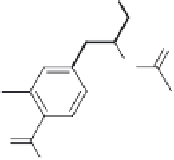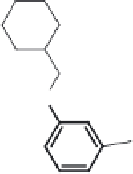Chemistry Reference
In-Depth Information
and are corrected with a penalty for discontinuous pieces. In Figure 8.5, the HSCS andMCS
are equal. Common substructure methods, such as the MCS and HSCS, are used to detect
and visualize structural similarities between molecules.
[
21
]
In addition, the HSCS has been
applied for discovery of common chemical replacements and to find fragments associated
with multiple biological activities.
[
22, 23
]
These applications are described in Section 8.3.3.
O
H
O
O
H
2
N
O
HN
O
HN
O
O
O
H
O
OH
Figure 8.5
Maximum Common Substructure of two molecules (MCS, drawn in bold). The
structure on the left is the example structure from Figure 8.1. The structure on the right is
vanillyl-
N
-nonylamide, IUPAC name
N
-[(4-hydroxy-3-methoxy-phenyl)methyl]nonanamide,
PubChem CID 2998.
8.2.3 Building Blocks
The fragmentation methods described in the previous section all use the 'full substructure
set'. Despite the high level of detail of these approaches, exhaustive study of all possible
fragments can be costly, however. Amore restrictive, but still sensible, approach may be to
focus on chemically meaningful fragments only, instead of including every single fragment
in a study.
Molecular building blocks.
To accomplish this, compounds are dissected into molecular
building blocks. This method splits molecules into nonoverlapping structural parts accord-
ing to a predefined set of breaking rules. These rules follow from the definition of
individual building blocks. This approach yields (chemically) more intuitive fragments
such as rings/ring systems, linkers, side-chains, functional groups, etc. Figure 8.6 illus-
trates the derivation of building blocks. A typical compound (Figure 8.6a) is fragmented
into molecular parts, according to the method described by Bemis and Murcko.
[
28
]
Three
ring systems (Figure 8.6d) are at the core of this compound, which are connected by two
linkers (Figure 8.6e). Together, ring systems and linkers form the molecular framework
(Figure 8.6c). Attached to this framework are the five side-chains (Figure 8.6b), yielding








